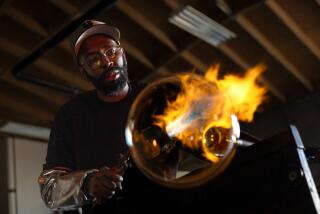Thomas Fuchs moves beyond the elaborate chandelier

In his Irvine studio, Thomas Fuchs assembles a custom designed chandelier made of individual glass spheres hand blown in Murano, Italy. The home accessories designer from New York City is opening a new glass blowing factory in Los Angeles, where he will be making new glassware collections in an exclusive collaboration with Saks.
- Share via
Barneys’ first eight deliveries of Thomas Fuchs tableware and barware never even made it onto the sales floor.
“The salespeople sold them immediately to their clients,” Fuchs said of the line, which was predicated on various iterations of skulls.
Some two years later, Fuchs has retained the skull pattern in the Remains Collection while adding some lighter motifs: butterflies, eyes, bamboo, even the female form.
New York-based Fuchs is a noted designer of substantial glass lighting pieces. His chandeliers, under the label Otium, can sell for $30,000 and are available mostly to the trade through Los Angeles showroom Egg & Dart.
But he is making as much of a name for himself with an extensive array of more accessible pieces — drinking glasses, cheese boards, drink stirrers, hefty Champagne buckets — that range in price from $5 to $725.
Fuchs was in Southern California recently to visit a glass-blowing factory in Irvine, where he is working on a series of eight lighting fixtures that among them will use 3,000 glass “bubbles” ranging in size from 1 1/2 to 5 1/2 inches.
He was also showcasing his latest tabletop offerings under the TFC — Thomas Fuchs Creative — label, white marble Champagne buckets with iridescent butterfly-shaped handles inlaid with abalone. And he was introducing his POV (Point of View) collection, which uses the eye as a motif, with a Champagne bucket featuring eye-shaped handles made with lapis lazuli, onyx and mother-of-pearl.
Fuchs had his Otium line — made largely in Murano, Italy — for a decade before he decided to create a line of small home accessories in marble, metal and glass. He found a craftsman in Agra, India, who works with Makrana marble, the same milky white stone used in Agra’s iconic Taj Mahal. The substance is incorporated into the range of Champagne buckets, and the same artisan also makes colored drinking glasses for the line.
Fuchs said the debut skull line tapped into what he described as “masculine barware.”
“I wanted some of the pieces to have more of a masculine edge,” he said. “Even the glasses have a masculine scale. They are larger than a double old-fashioned and have the skull stamp on the side.”
But Fuchs realized that women were buying barware as well. He added drink coasters and stirrers and started mixing things up, adding wine glasses, with butterflies and motifs inspired by the traditional bamboo scaffolding used in construction in Hong Kong. His cheese boards feature inlays of semiprecious stones. There is an evident connection between his sprawling, extravagant lighting and his small, hand-held pieces, which are lavish and rich with detail.
“[He] is well known for his beautiful Murano glass lighting,” said Tom Kalenderian, Barneys New York executive vice president. “It’s no wonder that he was equally inspired to create handmade Venetian drinkware, demonstrating his talent to apply his high design sensibility to everyday objects.”
The Remains Collection is “just the right dose of Goth blended with beautiful materials,” Kalenderian said, and it remains a top seller at the stores.
Fuchs, who used to live in Los Angeles and San Francisco, anticipates spending more time in the Southland because of his new relationship with the Irvine glass factory.
Set in a commercial and industrial area, the factory looks nondescript from the outside. But inside, it opens up to a cavernous space featuring several furnaces and a large open fire, high ceilings, domed spaces and pots of color for dipping. A pile of fine white sand from Normandy, France, is set on one side. As happens in Italy, the head of the factory is called “Maestro” by those who work there.
And even though the factories Fuchs works with in Murano date back hundreds of years, inside the mechanics and structures of glass-blowing workshops around the world are essentially the same, even if they were more recently built, he said.
“Glass blowing is an artisanal tradition that needs to be saved,” he said. “It’s a craftsmanship that began in the 1600s and is still being done in the same techniques. Now we might have the use of electricity and gas — but it’s still the same elements of sand and ash and heat. Twelve hours later, there’s an object. There’s a magic to that.”






